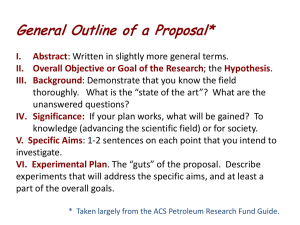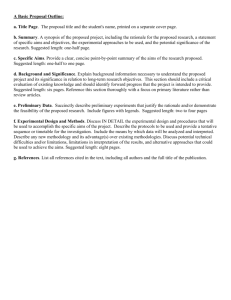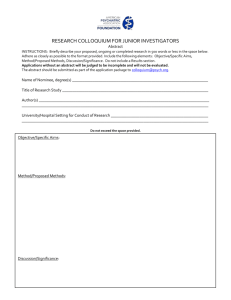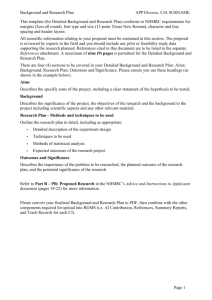96.11.14生物醫學領域許桂森教授
advertisement
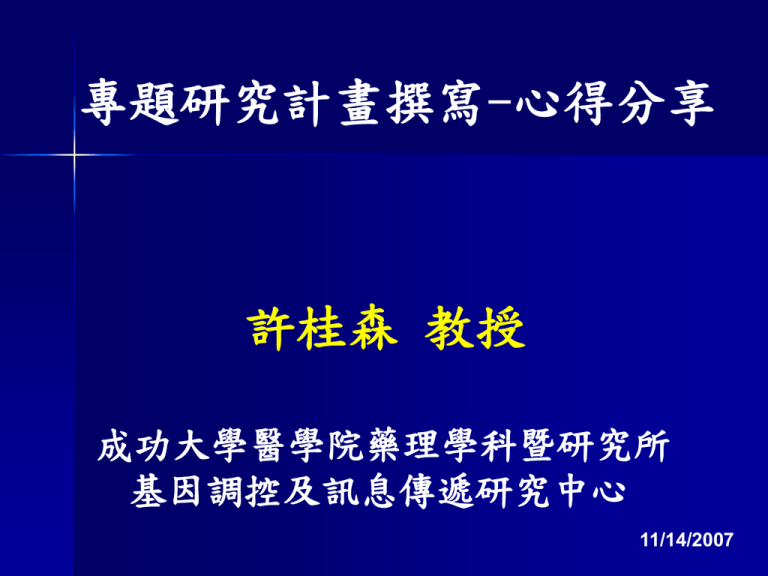
專題研究計畫撰寫-心得分享 許桂森 教授 成功大學醫學院藥理學科暨研究所 基因調控及訊息傳遞研究中心 11/14/2007 Research Grant What do you intend to do? Why is the work important? What has already been done? How are you going to do the work? - Think Like a Reviewer - A strong proposal 1. 2. 3. 4. Research significance: Important problems Research approach: Address the aims Innovation: Novel concepts, approach methods Investigator: appropriately trained, record of publication 5. Environment: Scientific environment contribute to the probability of success Clear, Logical and Brief Ideals Rationale Research Questions Why ? Preliminary Studies HYPOTHESES Literature Review Specific Aims Objectives What ? Experimental Design How ? PROPOSAL PROBLEMS (I) (10 most common reasons for proposal failure) 1. Lack of original ideas 2. Diffuse, unfocused, or superficial research plan 3. Lack of knowledge of published relevant work 4. Lack of experience in essential methodology 5. Uncertainty concerning future directions From NIH PROPOSAL PROBLEMS (II) 6. Questionable reasoning in experimental approach 7. Absence of acceptable scientific rationale 8. Unrealistically large amount of work 9. Lack of sufficient experimental detail 10. Uncritical approach Writing the Proposal 1. 2. 3. 4. 5. 6. Title Abstract (English and Chinese) Background and Significance Objectives and Specific Aims Preliminary Studies Experimental Designs and Methods: Timetable 7. Expected Results 8. The Budget 9. Biographical Sketch, Research Support and Resources Title Concise, Attractive and Succinct Correctively reflect the contents of the proposal Chinese and English titles should be consistent “Conditional knock out mice to explore the role of MAGUK scaffolding proteins in glutamate receptor trafficking” Abstract and Specific Aims (I) The most important pages in the proposal First impression to the reviewers One page is recommended Not too many aims Chinese and English abstracts should be consistent 1. General goal/significance 2. A theoretical framework or model 3. Hypotheses 4. Tests of the hypotheses (Specific Aims) Abstract and Specific Aims (II) Females and males are different in brain and behavior. Females are more susceptible than males to stress-induced affective disorders and twice as likely to experience depression. These differences are probably underlined by sexual dimorphisms observed in the hypothalamicpituitary-adrenal (HPA) axis activity/response to stress and its interaction with the central neurotransmitter systems. The overall HYPOTHESIS to be evaluated is that sex alters behavioral and physiological responses to stress and estrogen exerts both organizational and activational influence on the sex differences in response to stress through the regulation of brain-derived neurotrophic factor (BDNF) and its signaling pathways. Abstract and Specific Aims (III) Specific Aims: (1) Investigate whether the stress-induced alterations of the inducibility of hippocampal long-term synaptic plasticity (e.g., long-term potentiation and long-term depression), anxiety and behavioral depression are affected by sex and gonadal hormone fluctuations occurring during the estrous cycle. (2) Determine whether variations in the BDNF levels or its signaling cascades during the estrous cycle in females is a contributing factor to cause the sex differences in the stress-induced affective disorders. (3) Evaluate whether females are more vulnerable in the application of chronic mild stress model of depression using additional/novel short-term stressful procedure tests, such as the forced swim test and learned helplessness paradigms, and to determine whether the sex differences in chronic mild stress are permanently by the action of gonadal steroids during prenatal and/or postnatal periods of development. Abstract and Specific Aims (IV) Significance. Understanding why individuals exhibit differential responses to stress-induced affective disorders is important to further the basic science of stress vulnerability as well as to effectively treat and perhaps prevent stressrelated affective disorders in at-risk individuals. Don’t write long background or discussion in this section. Background and Significance (I) Not a literature review TWO TO THREE PAGES ARE RECOMMENDED. Update background description 1. The project is important. “What impact will the results of this research have on other research in the field or on our understanding and treatment of disease?” 2. The Science is interesting. New ideals, new experimental approaches, new hypotheses, new interpretations of old data 3. There is a high probability of success. Background and Significance (II) The significance of the work has better to very obvious to the reviewers. Use diagram to present a basic theory and indicate the relationship of the specific aims and the individual experiments to the theory. Literature citations should consist of no more than 30-50 entries. All of the papers cited must be carefully read and understood. They should be of excellent quality and not controversial. Reviewer ????? 1. Are the aims logical? 2. Is there a valid hypothesis possible? 3. Are feasible tests of the hypothesis possible? Would such tests produce new data? 4. What is the significance and originality of the proposed research relative to its scientific field? Preliminary Studies (I) A great impact on the eventual success of the proposal 1. You have experience with most of the experimental techniques proposed in the application. 2. You can design logical, wellcontrolled experiments 3. You will present your results in a clear and thoughtful manner. With clear and complete figure/table legends, calibrations, statistical analysis, etc. Preliminary Studies (II) Don’t just show raw data. Show only results that are relevant to the proposed experiments, and explicitly point out their relevance Don’t overstate your claims or ignore different possible interpretations. Hypothesis A HYPOTHESIS consists either of a suggested explanation for a phenomenon or of a reasoned proposal suggesting a possible correlation between multiple phenomena. Based on experimental data Use relevant literatures and preliminary data Don’t confuse hypothesis with method It is worth repeating . Research Design and Methods (I) Research design is very different from Method. Design is what will be done but Method is how it will be done. It reveals much about the depth of the thinking of the PI. Research Design subsection should answer the question, “what will be done in order to accomplish the Specific Aims? Be logical and step-by-step leading to your specific aims Research Design and Methods (II) Specific Aim 1 (verbatim as in the Specific Aims) Hypothesis (verbatim as in the Specific Aims) Experiment 1: Title Hypothesis corollary to be tested Rationale, if appropriate Design: list procedures (Flow chart or Table) Data expected, analysis and interpretation Problems and solutions, if appropriate Experiment 2: Title Hypothesis corollary to be tested Rationale, if appropriate Design: list procedures Data expected, analysis and interpretation Problems and solutions, if appropriate Research Design and Methods (III) Updated technologies Alternative approaches Control experiments Method list The project timetable: grant chart is convenient and concise Expected Results Why good results will be expected Alternative interpretations of the results How the results will support your hypotheses Perspectives References Correspond to the text Updated Consistent format No more than 30-50 entries Not review article only The Budget Reasonable (10%) Justifications for purchasing the equipment needed and large request Personnel and Travel Keys to good proposal writing Precise (精確) Logic (條理) Succinct (簡明) Meticulous (嚴密) Relevancy (關聯) References 1. 如何撰寫研究計畫 陽明大學 徐明達 教授 11/16/2006 2. 如何撰寫研究計畫 中山大學 陳慶鏗 教授 11/24/2006 3. Research Proposals- A guide to success Ogden and Goldberg (2002) Third Edition. 4. Scientific Methods: survival skills for young investigators in biomedical research Prof. Tung-Tien Sun Thank you for your attention
